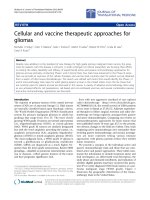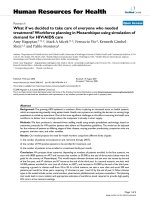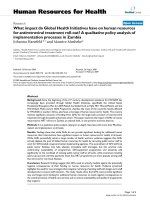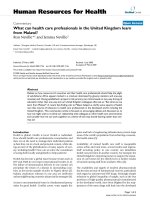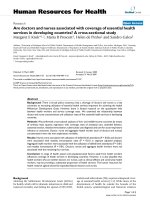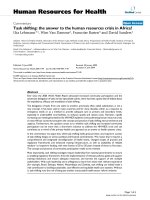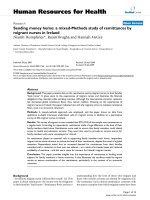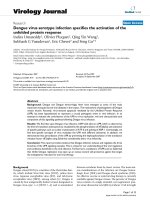báo cáo sinh học:" What if we decided to take care of everyone who needed treatment? Workforce planning in Mozambique using simulation of demand for HIV/AIDS care" pdf
Bạn đang xem bản rút gọn của tài liệu. Xem và tải ngay bản đầy đủ của tài liệu tại đây (252.58 KB, 9 trang )
BioMed Central
Page 1 of 9
(page number not for citation purposes)
Human Resources for Health
Open Access
Research
What if we decided to take care of everyone who needed
treatment? Workforce planning in Mozambique using simulation of
demand for HIV/AIDS care
Amy Hagopian*
†1,2
, Mark A Micek
†1,2
, Ferruccio Vio
3
, Kenneth Gimbel-
Sherr
1,3
and Pablo Montoya
4
Address:
1
Departments of Health Services and Global Health, University of Washington School of Public Health and Community Medicine, 4534
11th Av. NE, Seattle, WA 98105, USA,
2
Health Alliance International, Seattle, Washington, USA,
3
Health Alliance International, Maputo,
Mozambique and
4
Health Alliance International, Beira, Sofala, Mozambique
Email: Amy Hagopian* - ; Mark A Micek - ; Ferruccio Vio - ;
Kenneth Gimbel-Sherr - ; Pablo Montoya -
* Corresponding author †Equal contributors
Abstract
Background: The growing AIDS epidemic in southern Africa is placing an increased strain on health systems,
which are experiencing steadily rising patient loads. Health care systems are tackling the barriers to serving large
populations in scaled-up operations. One of the most significant challenges in this effort is securing the health care
workforce to deliver care in settings where the manpower is already in short supply.
Methods: We have produced a demand-driven staffing model using simple spreadsheet technology, based on
treatment protocols for HIV-positive patients that adhere to Mozambican guidelines. The model can be adjusted
for the volumes of patients at differing stages of their disease, varying provider productivity, proportion who are
pregnant, attrition rates, and other variables.
Results: Our model projects the need for health workers using three different kinds of goals:
1) the number of patients to be placed on anti-retroviral therapy (ART),
2) the number of HIV-positive patients to be enrolled for treatment, and
3) the number of patients to be enrolled in a treatment facility per month.
Conclusion: We propose three scenarios, depending on numbers of patients enrolled. In the first scenario, we
start with 8000 patients on ART and increase that number to 58 000 at the end of three years (those were the
goals for the country of Mozambique). This would require thirteen clinicians and just over ten nurses by the end
of the first year, and 67 clinicians and 47 nurses at the end of the third year. In a second scenario, we start with
34 000 patients enrolled for care (not all of them on ART), and increase to 94 000 by the end of the third year,
requiring a growth in clinician staff from 18 to 28. In a third scenario, we start a new clinic and enrol 200 new
patients per month for three years, requiring 1.2 clinicians in year 1 and 2.2 by the end of year 3. Other clinician
types in the model include nurses, social workers, pharmacists, phlebotomists, and peer counsellors. This planning
tool could lead to more realistic and appropriate estimates of workforce levels required to provide high-quality
HIV care in a low-resource settings.
Published: 7 February 2008
Human Resources for Health 2008, 6:3 doi:10.1186/1478-4491-6-3
Received: 19 August 2007
Accepted: 7 February 2008
This article is available from: />© 2008 Hagopian et al; licensee BioMed Central Ltd.
This is an Open Access article distributed under the terms of the Creative Commons Attribution License ( />),
which permits unrestricted use, distribution, and reproduction in any medium, provided the original work is properly cited.
Human Resources for Health 2008, 6:3 />Page 2 of 9
(page number not for citation purposes)
Background
AIDS treatment advocates have finally prevailed in the
public health debate about whether it is cost-effective or
appropriate to launch wide-scale treatment programs for
high-prevalence populations in low-income countries.
The initial years of the global AIDS epidemic were charac-
terized by both poor treatment options and an emphasis
on prevention. Political activists and public health profes-
sionals are now on the same page: it makes sense to
aggressively treat populations for AIDS using established
World Health Organization (WHO) protocols, as both a
preventive strategy and a way to mitigate the devastating
effects of the disease on a primarily young population [1].
We have collectively turned our attention to the range of
practical issues related to efforts to ensure universal access
to treatment.
Pilot programs have long-since demonstrated that we can
deliver appropriate treatment protocols and procedures.
Now, public health and health care systems are tackling
the barriers to serving large populations in scaled-up oper-
ations. One of the most significant challenges in this effort
is securing the health care workforce to deliver the care in
settings where the manpower is already in short supply
[2,3].
This paper describes a simple spreadsheet-based model
designed for use by Ministries of Health or other parties
planning large-scale AIDS treatment programs to estimate
personnel needs. Our model allows the user to change a
series of assumptions to estimate the impacts of various
'what if' scenarios. This model is based on the situation in
Mozambique, in sub-Saharan Africa, but was designed to
be generalizable to any low-resource setting attempting to
estimate the workforce needs of scaling up for AIDS treat-
ment.
There is little in the literature on health workforce model-
ling techniques for resource-poor settings, especially on
means for estimating requirements based on patient
demand. Most health workforce planning uses practi-
tioner-to-population ratios, historical patterns, and pro-
fessional judgment. More sophisticated analyses may
allow estimating workforce size and mix through use of
case-load profiling, acuity measures, or a combination of
factors in regression analysis [4,5]. Dreesch, Dolea et al.
have developed an approach to estimating human
resource requirements based on time needed to address
health deficits of the population [5]. An unpublished
2004 WHO model is an exception to this, as it offers a
'user guide' to increasing access to anti-retroviral therapy
(ART) by assessing health workforce needs [6].
Hirschhorn and colleagues, in estimating workforce needs
for AIDS treatment in resource-limited settings, suggest a
task-based approach to "explore the effect of reassigning
tasks to other cadres" of health personnel [7].
Larry Faulkner has written about estimating psychiatric
workforce requirements based on patient needs, and
offers a simple formula for making calculations: (#
patients needing care × amount of treatment time
required)/amount of time offered per psychiatrist =
number of psychiatrists required) [8].
The Challenge in Mozambique
Mozambique's 2006 HIV prevalence among 15–49 year
olds is extrapolated from 2004 figures, and stands at 16%,
with 1.65 million adults and children living with HIV/
AIDS [9]. The 2006 WHO AIDS epidemic update noted
that Mozambique shows a significant increase in HIV
infection levels since the turn of the century, and that
prevalence in pregnant women (15–49) rose from 11% in
2000 to 16% in 2004, one of the steepest increases seen in
sub-Saharan Africa in recent years [9]. Rising prevalence in
pregnant women may suggest that new infections con-
tinue to increase, a signal of further growth in the epi-
demic in Mozambique [9].
It is estimated that over 270 000 Mozambicans were clin-
ically eligible (under WHO guidelines) to receive ART in
2006. The country's National AIDS Strategic Plan
(2004–2008) aimed to enrol more than 34 300 people for
care in 2004, and more than 67 000 by 2005 [10] (See
Table 1). In addition to those enrolled for care who were
not yet eligible for ART, the plan called for 8000 people to
be on ART by the end of 2004 and 21 000 people by the
end of 2005. The Ministry of Health is reporting that as of
December 2006, over 160 000 individuals had been
enrolled for care (66 000 more than anticipated), and 44
100 were receiving ART (14 000 fewer than had been
hoped).
The United States Agency for International Development
(USAID) reported in 2004 that the health sector in
Mozambique faced enormous challenges, including weak
health infrastructure, significant budgetary constraints,
endemic poverty in the population, old and emerging dis-
eases, and poor health indicators [11]. The report
expressed particular alarm about the threat of HIV/AIDS,
both for the population in general and to the workplace
in particular.
Table 1: Mozambique strategic plan ART enrolment targets by
fiscal year (2004–2008)
Enrolment level 2004 2005 2006 2007 2008
ART drugs 7 924 20 805 57 954 96 418 132 280
Care w/o drugs yet 34 311 67 779 94 178 108 207 114 965
Human Resources for Health 2008, 6:3 />Page 3 of 9
(page number not for citation purposes)
Delivering HIV/AIDS Care in Mozambique: what staffing
model works best?
After starting with a fairly vertical 'day hospital' model for
HIV/AIDS patients, Mozambique has now moved to inte-
grate its HIV care into the existing health system. The HIV
integrated health network links voluntary counselling and
testing (VCT), prevention of mother to child transmission
(PMTCT), home-based care, and outpatient and inpatient
care.
We searched for existing guidance on staffing models for
Mozambique's ART initiative. USAID in 2004 had sug-
gested staffing norms that seemed to be fairly generic and
minimal [12]. These called for 1 physician and 3 nurses
per health facility without any regard for patient volumes
or treatment protocols. The report did note that varying
staffing models are in place from site to site, and called for
clarifying the treatment model before "projections of
overall human resources requirements for the ART scale-
up are worked out."
In a document dated about the same time, the Mozam-
bique Ministry of Health called for a different mix of staff
(1 physician, 1 nurse and 1 mid-level provider or medical
technician), but again with no reference to the number or
types of patients to be served with this staffing model.
Neither staffing standard takes into account the varying
numbers or stages of disease of the patients using the over
150 health facilities providing ART, nor do they differen-
tiate between fixed and variable staffing requirements. A
minimum fixed number of administrative staff is required
to organize care and systems, yet the number of these indi-
viduals required should be fairly independent of volumes
(or would only change in large incremental blocks of
patient volumes). A number of essential personnel catego-
ries, such as laboratory technicians, are not included at all.
Available workforce for HIV care is small, ratios are high
The number of people with HIV/AIDS divided by the
number of physicians in Mozambique indicates each phy-
sician needs to care for an average of 2155 HIV-positive
patients. The averages change, however, by urban or rural
status: physicians in Maputo City could be assigned 342
patients, while Zambesia-based physicians each have
6496 patients. This compares, for example, to a full-time
HIV care provider in the US, who can be asked to carry a
patient load of about 350 patients (personal communica-
tion, Robert Harrington, MD, medical director of the Uni-
versity of Washington/Harborview Medical Center HIV
Clinic). The numbers in Mozambique indicate that rural
physicians have a patient load that exceeds any reasonable
standards, and even the expectations of the 'average' phy-
sicians are extremely high, especially if one adds in patient
care and administrative responsibilities outside of caring
for patients with HIV/AIDS. Mid-level health workers
have the authority to prescribe ART in Mozambique.
This paper proceeds in the order we used to develop the
model: 1) we discuss the assumptions, 2) we present the
model (created in an Excel© spreadsheet, see Additional
File 1), 3) we discuss the results, and, finally, 4) we discuss
implications and conclusions.
Methods
We produced a demand-driven staffing model using sim-
ple spreadsheet technology, based on treatment protocols
for HIV-positive patients that adhere to Mozambican
guidelines. As such, it represents the minimum require-
ments to successfully complete protocols for HIV treat-
ment and accounts for some, but not all, the extra
encounters that could be generated by complications such
as opportunistic infections. The user can easily adjust for
the volumes of patients at differing stages of their disease,
varying provider productivity, proportion who are preg-
nant, attrition rates, and other variables.
Assumptions
We relied on the document, "Human Capacity Develop-
ment Assessment and Strategy Development for the
Health Sector in Mozambique," previously referenced,
and prepared by the Africa Bureau of USAID for some of
our assumptions. This document will be referred to as the
'USAID document.' We also relied on the personal knowl-
edge of four authors: Mark Micek, a physician with Health
Alliance International (HAI), who was involved in the
implementation of public-sector HIV treatment clinics in
Beira and Chimoio, Mozambique; Kenneth Gimbel-Sherr,
who is HAI's Mozambique country director and was
involved in developing the original national plan with the
Ministry of Health for providing HIV treatment nation-
wide; Ferruccio Vio, who works as Maputo Technical Sup-
port Coordinator for HAI; and Pablo Montoya, Central
Mozambique Field Director for HAI, where he supports
provincial planning for the Ministry of Health.
Demand
We assumed patients present to the health care system fol-
lowing a referral from one of a number of HIV testing sites
within a community, including VCT (voluntary counsel-
ling and testing) centres, PMTCT (prevention of maternal
to child transmission) centres, and hospitals, so they are
known to be HIV-positive upon arrival. Patient CD4
(Cluster of Differentiation 4) counts, however, are
unknown at the time of presentation.
Our model allows the user to input the distribution of
patients eligible for ART at their initial contact with the
clinic. We assumed that 45% of the HIV-positive adult
patients will need to be placed on anti-retrovirals upon
Human Resources for Health 2008, 6:3 />Page 4 of 9
(page number not for citation purposes)
presentation, and that another 5% of HIV-positive pre-
senters will be pregnant women who would also benefit
from immediate ART treatment. For those not initially eli-
gible for ART, we estimated that an additional 20% would
have initial CD4 counts from 200–349/mm
3
, 15% would
have CD4 counts between 350–499/mm
3
, and 15%
would have CD4 counts ≥500/mm
3
. These estimations
are based on the experience at Beira and Chimoio, where
it is notable that the proportion of people needing ART
exceeds UNAIDS and strategic plan assumptions. Patients
presenting for HIV care may not represent a cross-section
of all HIV-positive patients, but rather those who sought
testing and successfully presented for care at an HIV treat-
ment facility referral. The population who seek testing
may be in the more advanced stages of illness than those
who postpone. It should be noted, however, that the
model allows these assumptions to be changed depend-
ing on differing experiences at different sites. At this stage,
we are not including children in the analysis.
Our demand-driven model also provides the user with an
opportunity to input a variety of additional assumptions,
including 1) the proportion of those eligible for ART who
would start treatment (we assumed 70%), 2) the propor-
tion who will leave the care system secondary to death or
loss to follow-up (we assumed 10% per year for those on
ART, 50% for those enrolled but not eligible for ART), 3)
those with adverse drug reactions (we assumed 10%), and
4) those who experience a lack of clinical improvement
and therefore may require more encounters (we assumed
10%).
We assumed patients start ART according to Mozambique
Ministry of Health guidelines, which include all patients
with CD4 levels under 200 cells/mm
3
regardless of clinical
stage, a CD4 level between 200 and 349 cells/mm
3
if also
in WHO stage 3 or pregnant, or WHO stage 4 regardless of
CD4 count.
Schedule of encounters
Our approach was to identify several 'types' of patients,
and to map out the appropriate schedule of encounters for
each newly-presenting type of patient based on published
Mozambican guidelines [12].
'Encounters' in our model are from the care provider's
point of view. A single patient trip to the clinic could gen-
erate several encounters if the patient sees more than one
provider type during that trip. We will distinguish, there-
fore, between trips and encounters.
The first two patient trips consist primarily of assessment
and planning procedures (including obtaining CD4
counts), so these would be the same for everyone. Trip 1
generates one encounter with a nurse for a clinical evalu-
ation, and a separate encounter with a nurse who does a
blood draw. This sample is sent to the lab, which takes 7
days to process and receive results.
Trip 2 is a week later than the first, at which time there is
a single encounter with a nurse who evaluates the result of
the CD4 count and makes a staging decision about the
progress of the disease. This places the patient in one of
several categories based on initial CD4 counts and clinical
staging and on estimations about the rates in which peo-
ple may change clinical categories over the duration of the
3 years of the model.
The patients who would need ART immediately would
have an accelerated schedule of encounters: trip 3 would
be within a week of the second trip and would generate
two encounters: one with a clinician authorized to pre-
scribe ART (mid-level medical technicians have been
authorized to prescribe ART since June of 2006), and an
encounter with a social worker to review the care plan. For
these patients, trip 4 is with a social worker, as Mozam-
bique recommends three encounters with a counsellor
before ART is initiated. At trip 5, the patient is started on
ART. There are encounters with the social worker, phar-
macist and a clinician to discuss how the drugs will be
administered and how to take them. At trip 6, two weeks
after starting ART, there are encounters with a phleboto-
mist for haemoglobin and liver tests, a clinician, a phar-
macist, and a counsellor to assess the course of therapy
and review blood work results. Subsequently, these
patients have monthly encounters to a pharmacist, and
will see a clinician and counsellor at months one, two,
four, seven and ten after starting ART. For pregnant
women, encounters with a phlebotomist (for haemo-
globin) and a clinician are also required at six weeks to
monitor the side effects of AZT. Routine CD4 counts at
month four and every six months thereafter require a trip
and a encounter for blood draws. For each cohort starting
ART, we estimate that 10% will have significant reactions
or illnesses during the initial two months of treatment
that will require further clinical encounters. In addition, at
each CD4 draw time, we estimate 10% of patients will be
identified as potential treatment failures, and will require
additional encounters that are included in our model.
Again, these assumptions are modifiable depending on
differing experiences encountered at different sites.
For those patients who are not yet eligible for ART, we
scheduled nursing encounters to repeat CD4 testing at
intervals specified by Mozambique recommendations.
This includes encounters every three months for those
whose CD4 counts are between 200 and 349; encounters
every 6 months for those with CD4 counts between 350
and 499, and encounters every 12 months for those with
CD counts at or above 500.
Human Resources for Health 2008, 6:3 />Page 5 of 9
(page number not for citation purposes)
To estimate encounters in the second and third years of
follow-up for patients not initially ART-eligible, we esti-
mated the proportion of patients presenting in each of the
of clinical stages, and the rates at which these people may
change clinical categories over the duration of the 3 years
of the model. The encounter schedule will change, there-
fore, based on the progressing clinical stage.
Supply
The USAID document (p. 21) states that physicians can be
expected to work 1600 hours per year, or 200 working
days at eight hours per day. This assumes about 40 weeks
of work a year, or significantly below typical U.S. working
expectation of 45 to 48 weeks. Furthermore, the docu-
ment discounts those 1600 hours by an additional 20%
(ostensibly, but not explicitly, for administrative time) to
yield 1280 patient contact hours per year. With 1280 con-
tact hours per year over 200 days, or 6.4 hours per day, we
calculate an encounter takes 12 minutes and that a clini-
cian can be assigned roughly 6000 encounters per year.
Our model assumes nurses can be assigned 6000 encoun-
ters per year. A social worker would be able to complete
3000 encounters, and a pharmacist could process 10 000.
Peer counsellors, or activists, are projected to be able to
follow up five missing patients per day, and need is pro-
jected by multiplying 15% times the number of pharmacy
encounters. A phlebotomist would be able to draw blood
on 25 patients per day, or 5000 patients per year. Chang-
ing our productivity assumptions would change our staff-
ing requirements, of course.
The same document estimates there were 647 physicians
in Mozambique at the end of 2003, about 40% of whom
were specialists. A draft Human Resources Development
Plan calls for that number to more than double by 2010.
This plan further calls for an additional 1255 nurses
beyond the 4025 estimated to be practicing in 2004 [13].
In addition to the small numbers of personnel, other sup-
ply problems named include weak human resource man-
agement, too few administrative managers, low
motivation levels of health workers, high turnover or loss
of health workers secondary to HIV-related or other seri-
ous illness, and a shortage of protective equipment and
supplies. Our report does not address these issues.
Model
There are nine categories of health worker in our model.
These include:
1) Adult non-obstetrical (non-OB) clinicians (physicians
and ARV-trained mid-level medical technicians), trained
to make decisions about ART therapy;
2) Adult non-OB clinicians, who can manage ART ther-
apy, but are not trained or required to make decisions
regarding starting or changing ART regimens, and do not
need to be a physician or ART-trained mid-level medical
technician;
3) Obstetrical clinicians, trained to both start ARTs and
manage them through the patient's pregnancy;
4) Obstetrical clinicians who can manage ART therapy but
are not trained or required to make decisions regarding
starting or changing ART regimens;
5) Clinical nurses who can evaluate CD4 counts and make
referrals to clinicians for ART therapy;
6) Phlebotomists, who can draw blood samples for CD4
and other blood tests and send them to laboratories for
processing;
7) Social workers, who engage in pre- and post-ART coun-
selling;
8) Pharmacists, who dispense ART drugs; and
9) Lay peer-counsellors (Activistas), who are an important
component of the health care team but whose roles are
not well defined. These individuals are responsible for
finding patients who seem to be lost to follow up, and can
also support chart management and receptionists and per-
form other all-around tasks, such as adherence counsel-
ling, patient orientation, and HIV prevention counselling.
Our model consists of four interconnected spreadsheets
that build on each other but are relatively simple to under-
stand. See Additional File 1 for a live spreadsheet work-
book.
The fundamental spreadsheet (Worksheet A) uses the
individual patient as the unit of analysis. It has 36 col-
umns – one for each month of 3 years. The rows are
grouped into five categories of patient type based on their
health status at the time of enrolment: 1) those who need
ART now, 2) those with a low CD4 count (200–349) who
will need ART 'later' (within 1 year after enrolment); 3)
those with a low CD4 count (200–349) who will not need
ART within 2 years, 4) those who have CD4 counts of
between 350 to 499, and 5) those whose counts are at or
above 500. These numbers are automatically generated
based on the assumptions entered in the 'Assumptions'
section of Worksheet D.
Worksheet A maps out the encounters described in sched-
ule of encounters,' above, over a three-year period.
Human Resources for Health 2008, 6:3 />Page 6 of 9
(page number not for citation purposes)
The next spreadsheet (Worksheet B) also has 36 columns
(one for each month), but the rows consist of total patient
encounter counts generated in the patient-level Work-
sheet A, depending on the number of patients entered
into the system. These total counts are also grouped by
category of patient. The patient attrition assumptions
(entered by the user) are played out in this spreadsheet.
The third spreadsheet (Worksheet C) is a large one, and is
from the care system's point of view. Monthly encounter
counts generated by type of patient are totalled and sched-
uled over a three-year period.
The initial "input control" spreadsheet (on the same page
as Worksheet D) allows users to enter assumptions about
patient distribution characteristics as well as to select one
of three patient volume scenarios. Method 1 allows the
entry of a total number of people on ART in the system at
three time points one, two and three years after 'time
zero'. Method 2 allows the entry of a total number of peo-
ple for care (whether or not they are on ART) in the system
at the one, two and three year time points after 'time 0'
(these can be at either the clinic or national level). Method
3 allows the entry of a number of patients enrolled in a
care system per month (at either the clinic or national
level), and is intended to represent the care system's flows
during a steady state period. Only one method at a time
may be used. At this time, the model looks forward for
only a three-year period.
When patient volume inputs are entered, a 'Summary
Table' on the worksheet calculates numbers of patients
enrolled per month for each of the three years in the
model.
Results
Three scenarios generate different staffing configurations
Using each of the methods offered by the Input Control
portion of the model, we offer three scenarios and sets of
results by way of example. After inputting assumptions
and patient enrolment goals, we see results displayed in
the 'summary' tab of the Excel
©
workbook.
Scenario #1
We start year one with no one yet on ART and grow to
8000 starting ART by the end of year one. (for Mozam-
bique, this was 2004). We reach the Mozambique goal of
21 000 individuals starting ART at the end of year two,
and grow to 58 000 by the end of year three. See Table 2.
Scenario #2
We start year one with no one yet enrolled for HIV care.
We enrol 34 000 in the first year, and grow to 68 000 indi-
viduals at the end of year two. By the end of year three, we
are at 94 000 (which was the enrolment target for Mozam-
bique by the end of 2006). See Table 3.
Scenario #3
At the facility level, we model enrolling 200 individuals
for care per month, starting at 0 and enrolling 4800 indi-
viduals at the end of two years, and 7200 at the end of
three years (see Table 4).
In the first scenario, where we have 8000 patients on ART
at the end of year one and increase that number to 58 000
within two years (ending with 5753 non-OB clinician
encounters per month at the end of year one, building to
30 089 by the end of the third year), we would need to
increase from 11.5 non-OB clinicians to 60.2 non-OB cli-
nicians over the period. Pharmacists would need to
increase from 9.9 to 66.4 full time equivalents (FTEs).
In the second scenario where we have 34 000 patients
enrolled for care at the end of year one, and increase to 94
000 by the end of year three (i.e. monthly encounters with
non-OB clinicians climb from 7844 per month to 12568
per month). We would need to increase our non-OB clini-
cian staff from 15.7 to 25.1. Notably, in this model, 10
908 patients are started on ART by the end of year one,
and 36 228 by the end of year three.
Table 2: Results of our model, Scenario 1: 8000 starting ART by the end of year 1, ending with 58 000 starting ART by the end of year
3
Clinician type* End year 1 End of year 3
Number of non-OB encounters with clinicians 5753/month 30 089/month
OB encounters with clinicians** 712/month 3428/month
FTEs required to meet this demand based on our productivity
assumptions
11.5 non-OB clinicians
1.4 OB clinicians
10.3 nurses
28.4 social workers
9.9 pharmacists
12.7 phlebotomists
14.9 peer-counsellors
60.2 non-OB clinicians
6.9 OB clinicians
46.7 nurses
140.5 social workers
66.4 pharmacists
67.1 phlebotomists
99.6 peer counsellors
* Clinician calculations in table relate primarily to incremental requirements for HIV care **This category combines both ART decision-making
clinicians and ART follow up care providers, which are separated in the spreadsheet model
Human Resources for Health 2008, 6:3 />Page 7 of 9
(page number not for citation purposes)
In a third scenario, where we start a new clinic and enrol
200 new patients per month for two years, we would need
1.1 non-OB clinicians at the end of year one and increase
to 2.0 by the end of year three. In this model, 770 patients
are on ART by the end of year one, and 2738 are on ART
by the end of year three.
In any scenario, the assumptions concerning ART distri-
bution, patterns of progression of disease, proportion of
patients who experience adverse drug reactions, or num-
bers lost to follow up will all change the FTE requirements
generated. For example, an increase in the proportion of
pregnant women starting ART upon enrolment (from 5%
to 10%) changes scenario three from 0.2 OB clinicians to
0.4.
Discussion
Cautions and limitations
The numbers in our scenarios could be calculated at the
facility, district or national level. When making calcula-
tions at levels above the facility, however, the user is cau-
tioned to consider the FTE additions required to staff
multiple locations. We recommend making calculations
at the facility level and rounding up each facility's FTE to
units that can realistically be employed (0.5 or 1.0); these
individual facility numbers could then be added for dis-
trict or national calculations.
Our model is intended to generate calculations for incre-
mental workforce needs for scaling up HIV care only. Inte-
grated care facilities will need to consider workforce needs
for other health problems in addition to ART treatment.
These needs will include VCT, PMTCT, tuberculosis (TB),
home care, blood banks, mental health, maternity care,
sexually-transmitted disease (STD) care, and inpatient
care.
Our model at this point does not include administrative
staff. Users should add administrative FTEs based initially
on assumptions of how many fixed, baseline staff are
needed for such functions as reception, medical records or
data processing, human resources managers, operations
managers, and the like. For example, a clinic serving 5000
patients might need 6.5 administrative staff: 1 computer
support, 1 receptionist, 1 administrator, 2 janitorial, 0.4
counsellor supervisor and 1 driver. Some of these num-
bers would need to be increased for increases in encounter
volume.
Table 3: Results of our model, Scenario 2: Starting with 34 000 enrolled for care by the end of year 1, ending with 94 000 enrolled by
the end of year 3.
Clinician type* End year 1 End year 3
Number of non-OB encounters with clinicians 7844/month 12 568/month
OB encounters with clinicians** 971/month 1226/month
FTEs required to meet this demand based on our productivity
assumptions
15.7 non-OB clinicians
1.9 OB clinicians
14.0 nurses
38.7 social workers
13.6 pharmacists
17.4 phlebotomists
20.3 peer-counselors
25.1 non-OB clinicians
2.5 OB clinicians
14.3 nurses
53.0
social workers
38.3 pharmacists
28.2 phlebotomists
57.4 peer-counselors
*Clinician calculations in table relate primarily to incremental requirements for HIV care **This category combines both ART decision-making
clinicians and ART follow up care providers, which are separated in the spreadsheet model
Table 4: Results of our model, Scenario 3: Enrolling 200 patients per month, starting with zero.
Clinician type* End year 1 End year 3
Number of non-OB encounters with clinicians 554/month 1017/month
OB encounters with clinicians** 69/month 103/month
FTEs required to meet this demand based on our
productivity assumptions
1.1 non-OB clinicians
0.1 OB clinicians
1.0 nurses
2.7 social workers
1.0 pharmacists
1.2 phlebotomists
1.4 peer-counselors
2.0 non-OB clinicians
0.2 OB clinicians
1.2 nurses
4.4 social workers
2.9 pharmacists
2.3 phlebotomists
4.4 peer-counselors
*Clinician calculations in table relate primarily to incremental requirements for HIV care **This category combines both ART decision-making
clinicians and ART follow up care providers, which are separated in the spreadsheet model
Human Resources for Health 2008, 6:3 />Page 8 of 9
(page number not for citation purposes)
There are also training, cost and policy implications for
any model that is adopted that needs further exploration.
In any exercise of this sort, the assumptions are very
important in driving the conclusions. If we decrease the
number of newly-enrolled patients or the number of
encounters they require (demand), and/or increase the
productivity of care providers either by increasing the
number of hours or the number of encounters per hour
(supply), then fewer staff are required to serve patient
needs. Conversely, decreases in supplied staff hours or
increases in encounters will drive a higher demand for
health care staff. Our spreadsheet model allows for enter-
taining "what if" scenarios on both the demand and sup-
ply sides of the equations.
Conclusion
We offer this modelling system as a planning tool that we
hope will lead to more realistic and appropriate estimates
of the workforce levels required to provide high-quality
HIV care in a variety of settings. As sufficient numbers and
types of health workers are brought on line at all levels –
clinic, district, and national – we hope system planners
will see systematic improvements in such numbers as
amount of eligible patients on ART, and reductions in loss
to follow up. As these numbers change, the model
assumptions can be changed for the next planning cycle.
Additionally, we hope users of the model will see the
advantages of cross-training and task-shifting as a means
to meet workforce needs.
In the case of Mozambique, as elsewhere in sub-Saharan
Africa, the number of available health workers is so inad-
equate that the model simply illustrates the gap between
what the standards of care require and the supply availa-
ble to meet the need. Illustrating this gap, however, is an
important step in achieving the policy goal of escalating
the numbers of trained health professionals in the popu-
lation [2].
Competing interests
The author(s) declare that they have no competing inter-
ests.
Additional material
Acknowledgements
We very much appreciate the assistance of the Mozambique Ministry of
Health in this work. Amy Hagopian was supported by an agreement with
the U.S. Health Resources and Services Administration Global AIDS Pro-
gram. Mark Micek was supported in part by a National Institutes of Health
STD/AIDS Research Training grant (NIH T32 AI07140). Ken Sherr received
an ORACTA grant from the Doris Duke Charitable Foundation. Thomas
L. Hall, MD, DrPH, of the Department of Epidemiology & Biostatistics at
the University of California at San Francisco School of Medicine, reviewed
our model and made helpful suggestions for improvement. This study was
conducted by the staff of Health Alliance International, which receives fund-
ing from the Clinton Foundation, PEPFAR, and the World Bank Treatment
Acceleration Program. Additionally, this publication was made possible
through support provided by the Regional Centre for Southern Africa, U.S.
Agency for International Development, under the terms of Cooperative
Agreement No. 656-A-00-04-00021-00. The opinions expressed herein
are those of the author(s) and do not necessarily reflect the views of the
U.S. Agency for International Development.
References
1. WHO: Scaling up HIV/AIDS care: service delivery & human
resources perspectives. 2004 [ />ments/en/HRH_ART_paper.pdf]. Accessed February 1, 2008
2. Chen L, Evans T, Anand S, Boufford JI, Brown H, Chowdhury M,
Cueto M, Dare L, Dussault G, Elzinga G, Fee E, Habte D, Hanvo-
ravongchai P, Jacobs M, Kurowski C, Michael S, Pablos-Mendez A,
Sewankambo N, Solimano G, Stilwell B, de Waal A, Wibulpolprasert
S: Human resources for health: overcoming the crisis. Lancet
2004, 364(9449):1984-1990.
3. Guilbert JJ: The World Health Report 2006: working together
for health. Educ Health (Abingdon) 2006, 19(3):385-387.
4. Hurst K: Primary and community care workforce planning
and development. J Adv Nurs 2006, 55(6):757-769.
5. Dreesch N, Dolea C, Dal Poz MR, Goubarev A, Adams O, Aregawi
M, Bergstrom K, Fogstad H, Sheratt D, Linkins J, Scherpbier R,
Youssef-Fox M: An approach to estimating human resource
requirements to achieve the Millennium Development
Goals. Health Policy Plan 2005, 20(5):267-276.
6. Zurn P, Vujicic M, Dreesch N: Increasing access to Antiretrovi-
ral Therapy: A Model for Assessing Health Workforce
Needs. In Tools for Planning and Developing Human Resources for HIV/
AIDS and Other Health Services Management Sciences for Health,
World Health Organization, Boston; 2006.
Additional file 1
Workforce Modelling Workbook 17.xls. Three inter-linked spreadsheets
for calculating health workforce FTE requirements based on patient
demand assumptions. SUMMARY tab. a) user-entered demand inputs
and assumptions, and b) Worksheet D, which generates and displays the
FTE calculations of estimated need. ASSUMPTIONS tab. Worksheet A
maps out the schedule of encounters for each type of patient; Worksheet B
counts total patient encounters generated by Worksheet A; Worksheet C
generates monthly encounter counts over a three-year period from the care
system's point of view. CLINICAL ALGORITHM tab. Describes the
schedule of encounters required for each type of patient using the WHO
and Mozambique treatment guidelines.
Click here for file
[ />4491-6-3-S1.xls]
Publish with Bio Med Central and every
scientist can read your work free of charge
"BioMed Central will be the most significant development for
disseminating the results of biomedical research in our lifetime."
Sir Paul Nurse, Cancer Research UK
Your research papers will be:
available free of charge to the entire biomedical community
peer reviewed and published immediately upon acceptance
cited in PubMed and archived on PubMed Central
yours — you keep the copyright
Submit your manuscript here:
/>BioMedcentral
Human Resources for Health 2008, 6:3 />Page 9 of 9
(page number not for citation purposes)
7. Hirschhorn LR, Oguda L, Fullem A, Dreesch N, Wilson P: Estimat-
ing health workforce needs for antiretroviral therapy in
resource-limited settings. Hum Resour Health 2006, 4:1.
8. Faulkner LR: Implications of a needs-based approach to esti-
mating psychiatric workforce requirements. Acad Psychiatry
2003, 27(4):241-246.
9. USAID / WHO: AIDS Epidemic Update, Sub-Saharan Africa.
2006:15.
10. Ministerio da Salude: Plano Estrategico Nacional STI/HIV/SIDA
(2004-2008). 2004. Table 3 on page 9
11. Decima E, Dreesch N, Kiarie W: Human Capacity (HCD)
Assessment and Strategy Development for the Health Sec-
tor in Mozambique. In Draft Report, Management Sciences for Health
Management and Leadership Development Project, USAID Project
Number HRN-A-00-00-00014-00, Maputo; 2004.
12. Mozambique Ministry of Health: Organization and Management
Guide for the National Day Hospitals. 2004: page 27, 28.
13. Departamento dos Recursos Humanos (Ministerio da Saude):
Human Resources Development Plan (Plano de Desenvolvi-
mento de Recursos Humanos Periodo 2006-2010). 2005.


